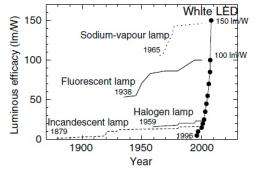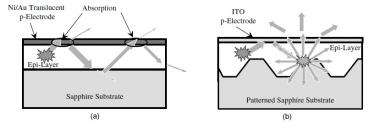August 31, 2010 feature
White LEDs with super-high luminous efficacy could satisfy all general lighting needs

(PhysOrg.com) -- Researchers from the Nichia Corporation in Tokushima, Japan, have set an ambitious goal: to develop a white LED that can replace every interior and exterior light bulb currently used in homes and offices. The properties of their latest white LED - a luminous flux of 1913 lumens and a luminous efficacy of 135 lumens per watt at 1 amp - enable it to emit more light than a typical 20-watt fluorescent bulb, as well as more light for a given amount of power. With these improvements, the researchers say that the new LED can replace traditional fluorescent bulbs for all general lighting applications, and also be used for automobile headlights and LCD backlighting.
The Nichia researchers, Yukio Narukawa, et al., have published the results in a recent study in the Journal of Physics D: Applied Physics. The team fabricated three types of high-luminous efficacy white LEDs, each of which utilized a variety of improvements in device structure to improve their luminosity, or brightness, and reduce their operating voltage.
The researchers focused on two measurement criteria. One was luminous flux (measured in lumens), which measures the light's luminosity as perceived by the human eye, whose sensitivity varies for different wavelengths. The second criteria was luminous efficacy (measured in lumens per watt), which measures the amount of luminous flux achieved with a given amount of power.
By the numbers
Briefly looking at the history of a few different types of light sources helps provide some context for the LED's recent rapid progress. The incandescent bulb, which was developed in 1879, had an initial luminous efficacy of 1.5 lm/W, which improved to 16 lm/W over the next 130 years. Fluorescent bulbs, first developed in 1938, achieved a luminosity increase of 50 to 100 lm/W over the next 60 years. The progress of white LEDs is much more pronounced: since their commercialization in 1996, white LEDs' luminous efficacy has increased from 5 lm/W to today's commercial white LED of 150 lm/W, the highest luminous efficacy of all white light sources. The theoretical limit for white LEDs is about 260-300 lm/W.
Now, the Nichia researchers have taken the white LED's luminous efficacy a step further, achieving values as high as 265 lm/W at 5 mA of current, or 249 lm/W at 20 mA, values that nearly reach the theoretical limit. However, the downside of this specific design is that the luminous flux is quite low, about 14.4 lm. By modifying the design, the researchers demonstrated two other white LEDs: one with values of 203 lm and 183 lm/W at 350 mA, and one (as mentioned above) with values of 1913 lm and 135 lm/W at 1 A. This last white LED was fabricated by connecting four high-power blue LED dies in series.

Design improvements
All three white LEDs are based on a blue LED die, which is coated with a yellow phosphor to achieve a wider emission spectrum. When blue emission from the LED die mixes with the yellow fluorescence from the phosphor, the device produces white light. Since the red part of the emitted spectrum was initially low, the researchers also added some red phosphor to enhance the red emission and create a more balanced spectra. Overall, the researchers noted that the color reproduction in this design is the highest of all white light sources.
To optimize the luminous efficacy, the researchers focused on a key problem of LEDs: the electrodes tend to absorb some of the light that could otherwise exit the device and increase its luminosity. To reduce absorption at the electrode, the researchers used an indium-tin oxide contact as one of the electrodes, and also used a patterned sapphire substrate to scatter the light so that it could more efficiently exit the device. The researchers also optimized the device to reduce the operating voltage from 3.08 to 2.80 V.
With these design improvements and the resulting enhancements in luminous efficacy, the new white LEDs provide further evidence that solid-state lighting can meet a wide variety of our future lighting requirements. Narukawa said that, although these LEDs are expensive compared to commercialized LEDs, he predicts that the price will come down in the future. He also plans to further enhance the luminous efficacy of the white LEDs for general lighting applications.
More information:
Yukio Narukawa, et al. “White light emitting diodes with super-high luminous efficacy.” J. Phys. D: Appl. Phys. 43 (2010) 354002 (6pp). DOI:10.1088/0022-3727/43/35/354002
• PhysOrg.com iPhone / iPad Apps
• PhysOrg.com Audio Podcasts / iTunes
• PhysOrg.com Android apps (new version available)
• Join PhysOrg.com on Facebook!
• Follow PhysOrg.com on Twitter!
Copyright 2010 PhysOrg.com.
All rights reserved. This material may not be published, broadcast, rewritten or redistributed in whole or part without the express written permission of PhysOrg.com.

















